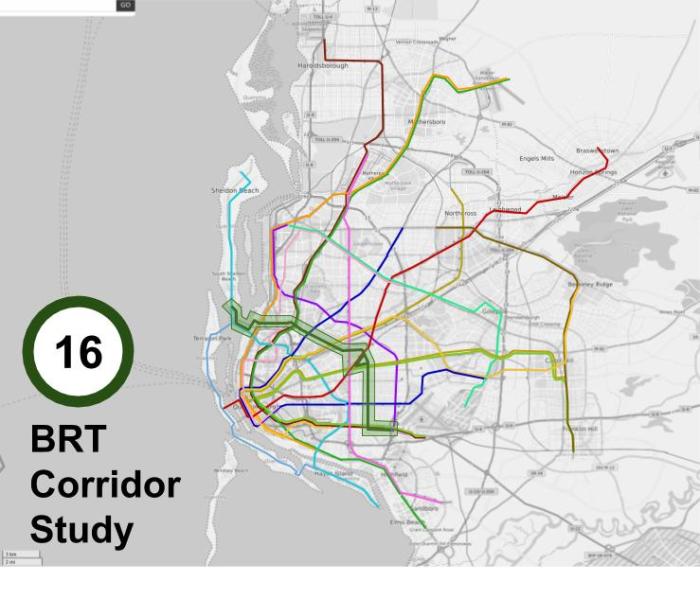QUENTINSBURGH, FREEDEMIA– QUARTA, releasing their new 2030-2050 plans, has announced several major corridor studies, starting with a short term study they are launching now for a Line 16 BRT to serve the Jackson Blvd/Stanley Rd corridor, building on the success of the Line 15 BRT serving the islands off the coast that opened in 2016.
Currently, bus route 33C provides frequent (usually about every 6 minutes) reliable local bus service to Jackson Blvd and Stanley Road, and the ALink and BLink select bus service lines, remnants of an early failed attempt at BRT, run along Stanley Rd, providing some limited stop service to the corridor. However, this new plan would call for the construction of a complete busway along Jackson Blvd and Stanley Road, similar to the existing Line 15 BRT running between Shelton Beach, Terrapin Park, Quentins Point Beach, and Hayes Island. Stations will require pre-boarding payment at turnstiles like the rest of the QLine metro system, and though mostly at grade, similar to a light rail, the BRT would run separate from traffic.

One major question the city faces is design. The arrangement of the lanes, especially around major difficult junctions such as Quentinsburgh/Capitol East (serving the Emmerly/Capitol/Quentinsburgh Transit Center) and in southern Shelton Beach (where it would end with the Line 15 BRT) needs to be figured out, and elements like flyovers would likely need to be restrained to the most necessary locations to keep costs down. However, this is a relatively short term project, with the environmental study planned to conclude by the end of 2018, and if the study makes it clear this project will work and demand exists, QUARTA hopes to have it completed by 2023-2025, depending on the amount of added construction of flyovers and stations that would be required.
QUARTA also announced several longer term corridor studies;
- West Mathersburgh Blvd Corridor, likely BRT or a branch of line 5 from Mathersboro to Haroldsburgh
- Bond Extension to Kettingdon Heights, proposed extension of line 2
- Hinespoint Rd Corridor, likely BRT or an extension of line 12; will not happen until demand increases
- Putnam & Grentens Corridors, likely BRT providing an E-W connection thru N Central Quentinsburgh
- Greendale Meadow/Greencreek Corridor, likely BRT, a branch of line 4, or a new line branching off line 3 to Gillepsie

The city of Gillepsie was especially happy about the Greendale Meadows/Greencreek Corridor Study, which would be the first project to try to extend the metro system, whether by subway or BRT, to connect Downtown Gillepsie with Downtown Quentinsburgh.
“We’ve managed to do okay in spite of it, but we’re the only major suburb in the area with no 1-seat metro ride to downtown Quentinsburgh,” Gillepsie Mayor Regina Thompson explains. “Other cities like Northcross, Highfield, Caroll Hill and Franklin Hill, and even far out areas like Haroldsburgh, Mathersburgh, and Horizon Springs have been given direct access to downtown. Why haven’t we? We’ve been well established for years and still isolated. They’ve talked about extending the 10 a couple extra stops to connect us to downtown when it’s finished, but even then, a local only train that runs through all of North and West Quentinsburgh before getting to downtown is barely more convenient than what we have now, and would be even longer than our current two-seat ride on the 11 and 7x.”
While routes haven’t been decided yet, the Gillepsie extension corridor has three alternative modes planned as options right now.
Option A would simply create a BRT line connecting Gillepsie with the Emmerly/Capitol/Quentinsburgh transit center, and is the cheapest alternative. There is a version (Option A2) that would have the BRT also run nonstop from Emmerly/Capitol/Quentinsburgh to Quentinsburgh Union Station, adding the extra service that would connect Gillepsie to downtown Quentinsburgh.
Option B would create a new elevated branch of line 4X that would run to Gillepsie, and the idea of how that would work and how it would affect existing routing is somewhat fuzzy. The QUARTA system doesn’t currently have any branching metro or BRT lines, so they don’t have any clear examples within the system to look to.
Option C, preferred among Gillepsians, would create a new elevated metro line, likely line 17, that would run with Line 3 from the terminus at Quentinsburgh Beach through Downtown Quentinsburgh and the Emmerly/Capitol/Quentinsburgh Transit Center and then branch off around Greencreek to run to Downtown Gillepsie, likely terminating alongside line 11. This alternative would provide local and express service to Gillepsie, but would also be the most expensive of the three. But Gillepsie residents say it’s worth it. And it would likely take pressure off of Line 4 as well, making it significantly preferable to the Line 4 branch alternative.
Many Kettingdon Heights residents are very hopeful about the line 2 extension. Similarly to Gillepsie, the neighborhood has a history of not having adequate metro connections to downtown Quentinsburgh.
“We’re living in one of the poorest parts of the city”, explained Jules Randolph, a father with 5 kids living in Kettingdon Heights. “And sometimes it can be difficult to get where I need to for work. I finally got a good paying job closer to downtown, but the subway doesn’t reach all the way out here so I have to take the local bus all the way in. Don’t get me wrong, the bus isn’t terrible, but it’s pretty slow and inconvenient. Our neighborhood has been a bit neglected, especially considering early plans from three decades ago showed lines running to Wally Cleaver and Kettingdon. They could have given us the service we needed with just a few extra stops built on, but they chose not to. But at least it looks like they might finally do it.”




